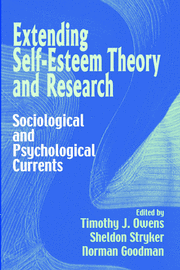Book contents
- Frontmatter
- Contents
- List of Contributors
- SECTION ONE THE FRAME
- 1 The Future of Self-Esteem: An Introduction
- 2 The Self as Social Product and Social Force: Morris Rosenberg and the Elaboration of a Deceptively Simple Effect
- SECTION TWO CONCEPTUAL AND METHODOLOGICAL ISSUES
- SECTION THREE SOCIAL AND LIFE COURSE CONTEXTS OF SELF-ESTEEM
- SECTION FOUR SELF-ESTEEM AND SOCIAL INEQUALITIES
- SECTION FIVE SELF-ESTEEM AND SOCIAL PROBLEMS
- Index
1 - The Future of Self-Esteem: An Introduction
Published online by Cambridge University Press: 24 November 2009
- Frontmatter
- Contents
- List of Contributors
- SECTION ONE THE FRAME
- 1 The Future of Self-Esteem: An Introduction
- 2 The Self as Social Product and Social Force: Morris Rosenberg and the Elaboration of a Deceptively Simple Effect
- SECTION TWO CONCEPTUAL AND METHODOLOGICAL ISSUES
- SECTION THREE SOCIAL AND LIFE COURSE CONTEXTS OF SELF-ESTEEM
- SECTION FOUR SELF-ESTEEM AND SOCIAL INEQUALITIES
- SECTION FIVE SELF-ESTEEM AND SOCIAL PROBLEMS
- Index
Summary
THE IMPORTANCE OF A MISUNDERSTOOD AND MISAPPROPRIATED CONCEPT
The hypothesized link between the self-concept and various social problems has commanded a long-standing place in social and psychological theory as well as public discourse. Nowhere is this notion more strongly held than in the presumed relationship between self-esteem and various social and emotional difficulties, especially – though certainly not exclusively – with regard to youth problems (Smelser, 1989). It is not uncommon to hear parents, educators, politicians, and religious leaders blame school failure, delinquency, risky sexual behavior, impudence, drug and alcohol abuse, and more on children's diminished self-esteems (California Task Force to Promote Self-Esteem and Personal and Social Responsibility, 1990; Mecca, Smelser, & Vasconcellos, 1989). Indeed, shortly after President Clinton's reelection, USA Today reported Secretary of Health and Human Services Donna Shalala as saying that, if she remained in the president's cabinet, she would work to raise the self-esteem of the nation's children.
The typical discourse on the relationship between self-esteem and various social and emotional problems is twofold. Self-esteem, it is argued, safeguards people against the ill effects stemming from many of life's problems. This premise assumes that people with high self-esteem, in contrast to those with low self-esteem, will behave in more socially acceptable and responsible ways, will somehow be more resilient to life's vicissitudes, will generally display higher achievement in conventional pursuits, and will ultimately possess greater socioemotional well-being (Burns, 1979; Covington, 1992). This rationalist view of high self-esteem is deeply embedded in Western culture, but especially American.
Information
- Type
- Chapter
- Information
- Extending Self-Esteem Theory and ResearchSociological and Psychological Currents, pp. 1 - 9Publisher: Cambridge University PressPrint publication year: 2001
Accessibility standard: Unknown
Why this information is here
This section outlines the accessibility features of this content - including support for screen readers, full keyboard navigation and high-contrast display options. This may not be relevant for you.Accessibility Information
- 4
- Cited by
